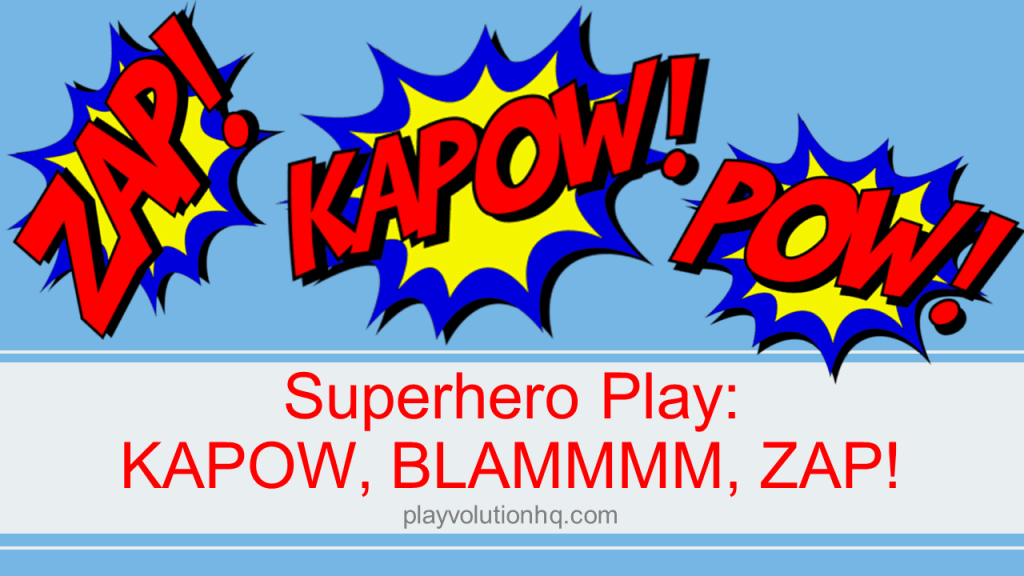Revised | Originally Published: July 4, 2021 @ 12:57 pm

Table of Contents
On the surface, superhero play is loud, violent-looking, messy, rowdy, hurly-burly, and rambunctious. It looks out of control and chaotic and often takes place at inopportune times and in unsuitable places:
- A freshly bathed Superman leaps between hotel room beds wearing nothing but a terrycloth cape as Mom pleads with him to quiet down and brush his teeth.
- Wonder Woman enthusiastically ties her smiling little brother to the kitchen table with her magic jump rope lasso while Dad makes mac-and-cheese.
- The Batman fights imaginary Joker henchmen to pass the time at Grandma’s funeral.
While superhero play, a form of power play, may not be appropriate everywhere at any time, it is worth making time and space for in early learning settings.

Learning Opportunities
The thing is, if you peel away the surface annoyances and look deeper, Superhero play is valuable and rich in playful learning opportunities. Here’s just a tiny part of what your little superhero could be learning with all the leaping and yelling:
- Physical Development–Superhero play builds muscle strength and control, visual tracking skills, coordination, balance, and proprioceptive awareness. It’s awash with opportunities to improve sensory integration. All that running, jumping, and flying is especially good at building core strength as well as strength and control in the arms and legs—things that have to develop before a child masters control of the small muscles in their hands and wrists used in writing. That’s right, superhero play is a pre-writing activity.
- Communicative Development–On the surface, superhero play sounds like a lot of yelling, but if you pay close attention, you’ll find that this type of play drips with language. Children engaged in superhero play expand their vocabulary as they try new words, develop listening skills, practice the give-and-take of conversation, and use language for problem-solving and negotiation. On top of all the spoken language, body language and written communication frequently work their way into the okay scenarios.
- Social-Emotional Development–Kids learn social skills through real-time practice, and superhero play is ripe with such opportunities. Among other things, Aquaman and those Ninja Turtles on the other side of the room are honing their self-control, practicing taking turns, learning to problem-solve, reading body language, negotiating, and delaying gratification.
- Cognitive Development–Superhero play also has abundant opportunities for thinking, planning, and organizing. Catwoman plans an audacious jewelry heist, the Fantastic Four coordinates the city’s defense, or Spiderman organizes his aunt’s surprise birthday party, for example.
- Adaptive Development–Superhero play supports the development of life skills and helps kids learn to navigate the world by fostering creativity, imagination, and social skills. It encourages kids to create scenarios, solve problems, and develop a sense of agency. It also helps children understand social roles, build empathy, and navigate complex peer interactions.

Big Concepts
Children enthralled with the zip and zoom of superhero play also explore big concepts like Power, Control, Heroism, Leadership, Life, and Death. These are weighty concepts for young kids to contemplate–their play is rich in subtext and symbolism. Play provides a safe, non-threatening environment for children to explore these complex themes. Playing at Death with your friends makes it easier to cope with the death of pets and loved ones in real life. Being a powerful hero saving the world while playing makes it a bit easier to be a responsible and kind big brother when it’s time to share your Hot Wheels with your little sister.
Social-Emotional Development
We touched on social-emotional development earlier, but let’s look deeper. Many adults don’t look closely enough at children’s superhero play to notice the social-emotional subtext that often drives the play.
It may be hard to see that pummeling each other with imaginary laser beams and beating each other with foam pool noodles promotes healthy emotional development, but it does. For children to learn to manage emotions, they need to experience them. Superheroing around is an excellent opportunity to explore big emotions: Anger, Fear, Anxiety, Stress, Passion, Joy, Sorrow, Anguish, and more. Remember, play is a haven for kids to explore complicated concepts—and we all know how complex emotions can be.
Learning to “be good” requires an understanding of what evil looks like. This is why some kids relish taking on the role of Bad Guy—it’s a chance to play at all the things they are repeatedly told not to do. Superhero play is also an excellent opportunity for kids to blow off steam and manage stress. It is hard work for many children to keep their hands to themselves, listen to their teacher, and live up to adult expectations all day—becoming The Batman is a chance to let loose.

Superhero Risk Management
Risk is a choice, a choice to do something or not. We don’t keep our kids safe by trying to remove all potential dangers from their lives; we keep them safe by helping them learn to recognize and assess those dangers in real time. We keep them safe by assisting them in identifying potential hazards and understanding their abilities and limits.
For example, knowing you can safely jump from the third step on the back porch requires lots of jumping experience. Once you have that experience-based knowledge, it’s easy to assess whether or not you are comfortable leaping from the retaining wall in your buddy’s front yard. You may choose to take the risk or not. Evaluating and managing risk takes lots of practice—and superhero play is rich in practice opportunities.

Embracing All The Superheroes
As you can see, under the surface, superhero play is rich in playful learning. That means we adults should step back a bit and find ways to embrace and support it in our homes and early learning programs. One of the first steps is being able to identify it.
You may be surprised to learn that a popular form of superhero play is not usually loud and wild; flying, lasers, and super strength are rarely involved. That’s because the most popular superhero is not Superman, Captain America, Iron Man, or The Incredible Hulk. The most popular superhero identity for young children to imitate, idealize, and play is Mom.

Think about it—in the eyes of most preschoolers, Mom is all-powerful and always in control. She solves problems, brings peace, and vanquishes scary shadow monsters at bedtime. If she says eat your peas, you eat your peas. Mom is more Super and Hero than anyone Marvel or DC has ever put in a comic book or on a movie screen. The only superhero more potent than Mom is Grandma—she has some strange psychic power over Mom.
Other, less rowdy superheroes are also usually welcome in early learning settings—princesses and fairies, for example. Tierras and magic wands are often more welcome than capes and lightsabers.
Playing Moms, Princesses, or Fairies gets a green light, space, time, and props. Playing Batman, Hulk, or Pirate receives a red light, a sigh, an eye roll, and maybe a Time Out. One of the biggest things we can do as parents and early educators to support all the playful learning of superhero play is to find ways to make Transformer, Ninja Turtle, Knight, Pirate, and Fantastic Four play as socially acceptable as Mom play.
Supporting Superhero Play
Once we wrap our heads around the idea that all superhero play has value, we can work to support Batman as much as we support Mom and Power Rangers as much as we support Fairy Princesses. Here are some suggestions:
- Time–Provide children with big hunks of time where they are free to lead their play.
- Space–Provide plenty of space safe for leaping, running, flying, and teleporting.
- Props–Provide lots of open-ended materials so children can create the needed props. Opt for cardboard boxes, tape, paper, blocks, markers, and other loose parts instead of store-bought costumes and plastic laser blasters.
- Trust–Trust the children to lead their own playful learning—even if you have to dig deep to see the value in it. Try not to interfere too much. Trust that playing at Batman is as valuable as playing at Mom.
Contribute content to Playvolution HQ
Brought to you by Explorations Early Learning
Browse Trainings

Post Author
Jeff Johnson is an early learning trainer, podcaster, and author who founded Explorations Early Learning, Playvolution HQ, and Play Haven.

Leave a Reply